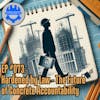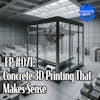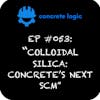EP #079: Bridging the Gap - The Concrete Lifeline
In this Concrete Logic podcast episode, Seth interviews Dan McCoy from R.L. McCoy about the life cycle of bridges and the importance of bridge maintenance. They discuss the process of maintaining bridges over time, including inspections, repairs, and replacements.
Dan explains the challenges of designing and maintaining bridges in a changing world, with increasing traffic volumes and evolving transportation needs. They also touch on the role of bridges in supporting commerce and the need for continued investment in infrastructure.
Overall, the conversation highlights the critical role of bridge maintenance in ensuring the longevity and safety of these vital structures.
Takeaways
- Bridge maintenance is crucial for ensuring the longevity and safety of these structures.
- The life cycle of a bridge involves regular inspections, repairs, and replacements.
- Designing and maintaining bridges is a complex task, with challenges such as increasing traffic volumes and evolving transportation needs.
- Investment in infrastructure is necessary to support commerce and meet the demands of a changing world.
Chapters
00:00 Introduction and Podcast Support
03:03 Discussing the Life Cycle of Bridges
28:35 Challenges in Infrastructure Maintenance
29:09 The Importance of Bridges in Transportation
30:14 Contact Information and Conclusion
***
Did you learn something from this episode? If so, please consider donating to the show to help us continue to provide high-quality content for the concrete industry.
Donate here: https://www.concretelogicpodcast.com/support/
***
Episode References
Guest: Dan McCoy | R.L. McCoy | danmccoy@rlmccoy.net
Guest Website: http://www.rlmccoy.net/
Producers: Jodi Tandett, Jace Stocker
Donate & Become a Producer: https://www.concretelogicpodcast.com/support/
Music: MikeDunton | https://www.mikeduntonmusic.com | mikeduntonmusic@gmail.com | Instagram @Mike_Dunton
Host: Seth Tandett, seth@concretelogicpodcast.com
LinkedIn: https://www.linkedin.com/in/seth-tandett/
Website: https://www.concretelogicpodcast.com/
LinkedIn: https://www.linkedin.com/company/concrete-logic-podcast
[00:00:00] Seth: Welcome to another episode of the concrete logic podcast. And today I have Dan McCoy with RL McCoy. He's back with us. You may remember Dan from episode 64. We talked about nano concrete. If you haven't listened to that episode, I highly recommend it. You get a contractor's view of some nano colloidal silica products that Dan uses.
, Dan, thanks for coming back on the show. Before we get started, though, I just want to remind everybody how you can support the podcast. , to remind you, this is a value for value model. , we provide the value of the podcast and then you all provide a value back and you can do it in one of the three ways or all three ways would be fantastic.
First share the podcast with a colleague or a coworker that's in the industry. Don't be selfish with all this new knowledge that you're learning, share it. The second thing you can do is reach out to me. And you can reach out to me on a couple different ways.
You can go to the ConcreteLogicPodcast.com website. There's a link there to contact me via email, or you can click on a, the microphone icon that's on there and you can leave me a voicemail, but what I'm looking for is some ideas or guest suggestions for the podcast. So that's number 2 and number 3.
If you're feeling like you want to donate some money to the show, you can do that as well., running a podcast isn't free. There's software hardware that it takes to put these things out. So whatever you're willing to do. Sharing with me or donate to the show is much appreciated.
If y'all follow my newsletter, I did share with you I got some unfriendly news from our credit card processor. They're kicking us off. Actually tomorrow, , they don't like the value for value model so they're kicking us off. So we're moved over to PayPal. You can still donate for now. And I had some folks reach out to me and suggest some other places that we can accept donations as well.
So I'm going to look into those. Everybody that reached out to me and Made suggestions I truly appreciate it. You taking the time and caring about the podcast. That is great.
Anyhow Dan let's get into it. So we're going to talk about the life cycle of bridges, which I have no experience of building bridges.
And Dan's the expert. He's in Indiana.
[00:02:32] Dan McCoy: Wow. I don't know if expert should be a word, we throw around here.
[00:02:35] Seth: I went to your website, and it says that's what y'all do bridge construction and renovation or something like that. This is renovation. I wanted to bring Dan on because I was sharing with Dan before we hit record is I have an extensive experience building parking garages and I actually did it on both the concrete side as a concrete contractor, but also on the general contractor side.
And when I was on the general contractor side, after we built a parking garage, we would turn over this maintenance manual over to the owner and say hey, you got this brand new spanking garage. It's going to last you the next 50 years, but you got to take care of it. And these are the things that you need to do to take care of it.
And we would do it. Yeah, show them what they need to do on a daily basis, a weekly basis, a monthly basis, an annual basis all the way out till, every, I think it was every 10, 20 year kind of cycle. I figured bridges would be the same way. I wanted to bring Dan in to talk about that because you're here on the news or wherever you get your, I want to I don't want to call it nonsense, but wherever you get your information from these days that all the bridges in the United States are failing and falling apart. And people point fingers that, we had bad concrete back then, or it was badly designed, or it wasn't installed correctly.
And., I don't hear someone say, hey, maybe we didn't take care of our bridges. Maybe we didn't maintain them. So Dan, I rambled on and off. It's your turn to ramble.
[00:04:08] Dan McCoy: Oh, well, thanks for having me on the show again. This is fantastic.
But yeah, you're don't take what you said about parking garages lightly, those are just bridges stacked on top of one so, just because, just because they stay in one place and the cars actually sit on them, they're no less important in design. Or a long term maintenance life cycle but if we want to get to the crux of maintenance each state to give a breakdown of bridges they're somewhat considered national assets in terms of defense.
So bridges are for most DOTs. Federal they have federal oversight, so federal highway. Overseas, almost every bridge contracts, not physically being out there, but they look at it from the front end and the back end for design pay items and what's being done to the structure. So, if we look at it in an overall view of that, just to run some numbers, if.
And yes, we do have bridge collapses every day. I want everybody to know that somewhere in the United States, there's just that many bridges somewhere in the United States, whether it be a county bridge or a little city bridge. And usually when I say county bridge it was traditionally that the counties.
Of the states are responsible for every bridge within the county, whether it's in a city or not. And usually, if the cities get large enough, they take over the maintenance, the maintenance and the inspection of these structures. So, a municipality and a, or a state agency is responsible. In law by the federal government to maintain these structures, but there's so many.
And if you include small structures, which are span less than 20 feet. So that would be your culverts that you see. Those are technically not bridges, but they are structures. And they have a different inspection sequence. I believe they're every 5 years. Bridges are every 2 years if they're in good condition.
If they're labeled structurally deficient, or they have an inherently deficient design flaw in them. From way back in the day, then they're changed to an inspection every year. But there is at least 1 bridge. In the United States that collapses every day. And I'm including small structures with that.
So sometimes you get a rain event where scour happens, and it washes away a call that comes. So it's not exactly the I 35 disaster that you see, or the bridge in Pennsylvania that collapsed that makes news. But yeah, you see those quite a bit and it was originally determined what's a realistic value for a life cycle for a bridge and the old standby has been 75 years.
So in counties. Obviously, we've had county roads a lot longer than we've had the Interstate Highway Act. So, the Interstate Highway Act 1956. So, if we just do some loose numbers here and we say, okay, we've got funding now, let's go get designed right away acquisition. Now, we're to the point where we're building bridges.
Let's give them the grace period of 10 years. That would put us at 1966 for a brand new shiny bridge. And then the life cycle or design life of that structure is meant to be 75 years. So that should get us to 2041 if we go off of that and but back then we didn't have the same design aids. We didn't have the same materials.
We did not for sure. We did not have the same traffic loading and traffic volumes that we have today. And most of those structures have performed more than adequately, um, on the far end. Yes, we need to do work. And yes, we need to do replacements, but those designers and contractors back in the day in the early 60s.
Really did a fantastic job of implementation of the interstate highway system. So, as I mentioned, the federal highway requires. And this came around the time it's been around a little bit longer, but it got a lot of attention with the I, 35 collapse. And it goes into the point that.
You're basically federally mandated to inspect every 1 of your bridge structures biannually or every 2 years. So you have to do a structure inspection and there's a point or an inspection list that the asset owner has to go through and then it's graded and then they perform a structure deficiency number.
And if. If that structure is found to be deficient on a scale, then it's moved to, basically, it's given a flag as a critical structure, and then it's moved to an annual inspection to see what elements of that have progressed in their failure. And there are several methods for maintenance and implementation of maintenance per state.
The states are the great experiment. So I'm going to speak on what. Indiana does. Which I wholeheartedly approve and it's always evolving. But if we look at a bridge, let's say we're going to build a brand new bridge. If we're just looking at that bridge how we're going to maintain that to get our 75 years out of it.
The Indiana Department of transportation does a wonderful job. In asset management and preventative maintenance. Olden days in the olden days, we dealt with expansion a little bit differently. So, thermal expansion is 1 of those things that you always have to deal with. We have wild temperature swings.
It's 110. In the summer, sometimes, and then in the winter, it gets down to negative 15. So, that's a, that is a, that's a pretty good thermal expansion for a long slender element that is a bridge. So, expansion and contraction was 1 of those things that was a problem. And it always will be a problem.
It's physics. You can't get away from it. But what I have seen lately in the last 1520 years, we've been doing integral conversions or semi integral conversions where we remove a large portion of the joint, or we remove a mud wall that's associated to the back end of an event. And has a joint on either side, you remove that and replace it with a single what we call a type 1 agent.
Which is really, just like it sounds, it's a simple saw cut or a cold joint that is separating the approach slab from the bridge structure. I think that alone to maintenance will go a long way in bridge design and bridge maintenance. I think it's probably 1 of the best things that we've done in the last 4 years.
So let's say we build a bridge like that today. We build a bridge like that today with really nice integral or semi integral vents. So we allow the vents to take up some of the expansion and contraction and they actually float on top of the pilot. The pilot actually moves in the ground, and it looks like a stick waving in the wind.
It's not that extreme, but I think you get the point in the expansion and contraction, and we let that deck go. Or the entire superstructure substructure go for a little less than 10 years and then the normal maintenance that you would do on that. That the state owner or agency would look at is.
Obviously, the biannual inspections, they would clean the bridge structure get all the deleterious material off the bridge. Look at drainage systems, things like that. And what Indiana does is if that bridge is less than 10 years old, or at least the wearing surface on top they'll place a 3, 8 polymeric overlay on it, which is a, it's just a very simple process of, basically placing an epoxy overlay.
on this existing surface to preserve that wearing surface. And every bridge is designed with a sacrificial wearing surface or a 35 pound per square foot additional load for a, an additional wearing surface if you want to put it on. So, that's all built into the design that goes into the maintenance cycle.
So, once that 10 years around 10 years is done, and we put a polymeric overlay on it now, we've probably, hopefully, we've got close to another 20 or 25 years with that polymeric. And so now, if we keep track, we're around 35 years old and now maybe we come in and we notice that, yeah we've got some, we've got some pockets that are popping out, or we've got some corrosion happening just below the surface.
That's causing some freeze thaw action and the decks getting a little old mainly the wearing surface. Well, then, at that age, you would come back in and you would put on, an overlay. You would literally put on a concrete overlay. Now we've done work with that in the past. I think we, we talked about that before with the work in nano silica for overlays but in the past, it used to be a silica fume overlay, which just had a high percentage.
I say high 5 up to 7%. Sometimes some studies went up to 15 percent of adding an additional silica fume, To an already stout bridge mix for an overlay. So you'll come in and you'll mill off the polymeric and then you'll scarify not so much remove a lot of the bridge deck But you will scarify the top to give it something rough for the overlay to grip to While you've got it shut down you'll perform an inspection Usually a chain sounding of the bridge deck and then any portions that sound hollow You Or any portions that are flagged to, by drains, or you can see obvious deformations in what you're looking for, those will be isolated, cut, patched and sounded again.
And then you'll come back on with an inch and three quarter or a two inch overlay. You'll place that overlay and then boom, that should give you in theory, that should give you about another 25 years. So we were at 35 years. And then we go up 25. So now we're at somewhere. I'm not real good at math, but what's that?
60 years? 60. Yeah. Yeah. So we're up at 60 years. And now we can even come back again after that 25 years. Hopefully it's lasted that long. Sometimes they don't, but it's all in plan. And you remove that overlay. And then you would mill then. So, in, in Ashto, we have a fairly good idea of what our deck can post.
We've got an 8 inch concrete deck. There's used to be 6 and a half inches structural. Just go with that. And we'll say 6 and a half inch structural. And then the remainder is basically fluff on top. So we've got a 1 inch clearance on the bottom. We generally have 5, 8.
two mats at eight inches on center. And then we've got a chair clearance for a second mat that goes on top of that, which is two and a half inches below the surface. So now we've got this overlay that's on it. We're going to remove that entire overlay, and then we're going to mill off. That additional two and a half inches.
It's usually two inches of the original bridge deck. We'll mill all that off and then we will sound it again and perform our patching. And then we'll put the 2nd overlay back on it and that, in theory, should give us another 1520 years that gets us to our 75 for that structure. But we're not done yet.
There are other things we can do, because if the inspection shows that the substructure is still great. So, piling hasn't failed, which it almost never does unless there's a scour issue or unless you've got some caustic materials that are eroding at the back and exposing it. So, usually the substructures remain in pretty good shape.
We don't worry about replacing those. So, the next thing we can do then is actually remove the deck. We can saw cut that deck out and leave if the beam elements are still good. A lot of these old steel girders. If they're maintained, and that means painted on a regular, if you include that into the maintenance cycle painted on a regular schedule, you remove that deck and then you place a new 8 inch deck on top of that.
And any modifications that you may want to make as a designer can be in there for that. I've seen in the past where some of these decks when they were originally placed are non composite. Which means that, it doesn't tie into the beam doesn't tie into the deck.
It's, it basically supports the dead load of the deck and the light load. But when they go back and redesign you can go back in and add shear studs used to be spirals in the old days. They actually had spirals in the, in like the 1965 handbook for federal highway that, it, they had calculations for putting spiral reinforcement down the flams of the beam.
But now mostly you use like a seven, eight shear studs. six, six inches tall or so, five and a half, six inches tall. And then that ties in a composite section. So they can actually get a little more light load capacity out of that when you're actually incorporating the final strength of the deck in the girder together and you'll place a new deck on it and boom, you can start all over again.
Wait 10 years, place another polymeric. Wait, another 15 or 20 years place another overlay. So, in that essence we're keeping up and we're going past the 75 year design. What times out a structure sometimes is, as you can see my wallpaper behind me, I like it because when 69, this is I 69 when it was implemented, you had four lanes, four north and four south.
And I remember talking to one of the old guys when it was first done and they drove from Fort Wayne to Indianapolis for a state house meeting and they counted a total of 27 vehicles in a two hour drive. They counted 27 vehicles. On 69 at the time when it was finished that I can count 27 vehicles from here.
If I look outside my window and just count and count the engine noises, I can do that in 13 seconds. That's how much traffic has changed. So it's, it is also a function. Of on the transportation side of are these arteries getting used? The volume is increasing. Loads are increasing. So sometimes it's more than what you bargained for.
And this one behind me is a perfect example of it's four lanes. But now to rebuild it, we can't even shut down a single lane. So you see we're putting in a temporary structure there to reroute traffic for a two year project to be able to route southbound traffic to that temporary structure so we can completely tear down the southbound side and rebuild it.
Then we'll switch and route the northbound onto the temporary structure and do that for the northbound. Oh, that's cool. Yeah, so it's very cool and you can get more. And even if you go into designs, we've seen variable depth, arch girders cast in place, and we've seen arch rings people ask what's the closest you can get to Roman concrete, and it's not so much the material is good, but you have to remember that the Romans weren't, working with steel.
So. They weren't as gutsy to go with long spans. and placing elements in concrete that are placed in a tension or compression zone. So if you want to make something last forever, you can do an arch that it places itself in compression for its entire life, which concrete loves compression.
And if you can continue to place that structure in compression it's almost endless, the capabilities as far as life cycle and lifespan. But yeah that's pretty much in dot in a nutshell. And then once that design life has been reached you then are looking at a total replacement.
But like I said, mostly what dictates that is usually not structure age. It's usually the development around the area. A lot of things change in civilization, 75 years population alone. And the use of it and urban sprawl. So you're, and you're looking some of the transportation things that we assumed in the 1960s, as far as side observation, vertical curve clearance even waterway overhead clearance for like, a Q100 flood event.
Those things change, so you have to elevate the bridge, make it wider, a larger riverway to, to go through because we've had, we have a freeze runoff in some areas. A lot of that goes into it as well. Not so much the structure and the elements that make the structure, but there's a lot in that is like, I hope that Seth, what do you think about that?
[00:20:27] Seth: Does that answer your question? At least for Indiana bridge maintenance. That was very thorough. I found a cool I don't know how many cool things are actually on the epa.gov website, but I found this chart here that shows weight of cars.
they actually have a chart in here that shows you from 1975 to present day. The average weight of every vehicle type that's out there. It's really cool chart, but like you said, it's increasing. if you build a bridge back in 75 and you assume that cars were going to stay the same weight you were wrong.
[00:21:06] Dan McCoy: And I think they knew they were going to be wrong. That's no surprise. But when you look at load cycles, that's why you have, factors, safeties and impact loads into bridge design. But even if you go into our future, let's talk frankly here, if we're going to EVs that's one of the things about EVs that a lot of people were surprised to hear is they're actually heavier than their partners.
Because batteries are heavy metals and the one thing about autonomous driving surprises a lot of people is, unlike a human it's perfect and it's driving down a lane. We deviate in our 12 foot lane quite a bit. You'd be surprised how much you deviate your 12 foot lane quite a bit.
You're constantly investing in street. If an autonomous driving vehicle. Is controlled by the same program as every other autonomous driving vehicle, and it sees every lane the same, then it will take the exact same lane path every time. So now your where path, instead of a 12 foot lane, or maybe 1 or 2 foot on either side, I'm sure we've all been driving down an asphalt highway, and ruts from trucks.
You're only going to amplify that with truck platooning with self driving cars. You're going to place all of that weight continuously on the same wheel path. Those are some things to think about. Those are some of the challenges that we come up with creating a smart highway system.
That a lot of people aren't aware of, so there's things that you can imagine that even if you're designing now, you. You can't plan for the future and 1 of those things is that so you try to design, especially bridge structures as robustly as possible. On a budget, right? The value of engineering. So a lot of that I would love to build.
I would love to build arches all day long. If you want something to last 120 years, 150 years, put in an arch or a 100 years at a minimum, but in without any maintenance you could put in a single span cast in place concrete deck, reinforced concrete deck something that's 22 to 27 inches deep, you're never after 100 years, it'll still be around, but you have to do the value engineering.
We just don't have the money in transportation or infrastructure to be the last transportation bill. I think, oh, what was it? 1. 1. 2 1. 5. I can't remember now because it's been about 2 years ago, but, if you look at the American society, civil engineers. And you go through the infrastructure rating and it's like what will it take to update our infrastructure and maintain our infrastructure?
The numbers are like eight, nine trillion, and that's just, that's not, they separate out. It's not, that's not just bridges, obviously, but that's highways, bridges, seaports, airports. Electrical grid is a huge one that we have to be concerned with. Are we falling behind? Yes. But I think as soon as you built something, you're falling behind anyway.
It's only as modern I've got the latest and greatest iPhone. It's already out of date, right? Because as soon as it goes into production, they've already, we're already designing something. It's progress, so that's what we're that's what we're dealing with. I'm not here to complain.
I'm here to say, please pay me more money. So I can go out and replace more of these bridges and build more bridges with responsible taxpayer dollars. That's what we're going for. If we want to continue this commerce, which I believe in my mind on a private infrastructure, well, a public infrastructure system there to serve the public, in the image behind me, there are a lot of trucks, they move a lot of product.
And to get to those local ports of destination, you can't use a train. You got to use trucks. And that's how they're going to have to get where they're good. Yeah. Yeah. That's not going away for sure. Not many, I, you can use your brain and think about, wow, what's a better way to get products to some places.
One of the most forward thinking companies there are is Amazon. And they do drone delivery and things like that. But. At all of their distribution facilities at any one time, you'll see about 150 trucks there. So, so they've thought it through and they use airplanes and airports and shipping methods and FedEx and UPS does the same thing.
But at the end of the day, they've got a lot of tractors and a lot of trailers and they need highways to get where they need to go.
[00:25:27] Seth: Yeah we build, those facilities and the number of dock doors. Is not decreasing, right? It's increasing. So they there's trucks out there that need to get to these facilities and they're trying to accommodate as many as they can.
So, yeah, I agree with that. I think we covered, what I was looking for today, Dan. So what we'll pause on that discussion today. If folks want to reach out to you, what's the best way?
Oh email Dan McCoy at RL McCoy. net is a great way. I think you can find me on LinkedIn, although I'm not one of those social media gurus.
So if you contact me via that way, I'm going to point you, if you're found to be relevant you're going to be pointed to my mobile number anyway. All right. For texts or emails. But that's if that's a good way to find me, you can find me on LinkedIn. If you want.
[00:26:20] Dan McCoy: we're on Facebook and that's dedicated to concrete pumping for the most part. We put a few bridge pictures in there that my guys get angry about every once in a while. The bridge guys, they get angry at the pump guys because the Pope guys get a lot of the glamor and attention because it is, it's pretty concrete.
They're very pretty. So, those are the things that we're selling to direct customers. I tell my bridge guys, if I had more people calling every week, wanting their own bridge. I would more than happily advertise more bridge, but you would be surprised at the difference in cost between running a concrete pump and having your own private bridge.
So, I have a lot less customer base when it comes to the bridges on that side of it, but yeah, Facebook, Instagram, just search RL McCoy. And YouTube. There's actually a lot of really neat videos that people want to know. I tried to do videos on YouTube specifically about questions that people had.
So I could answer most of those questions in about a seven minute video. So if you have some frequently asked questions about lightweight concrete or nano silicas. Liquid fly ash different industry trends. I don't update it very often because I like to say everything, I want to say in about that seven minutes.
As poor Seth is finding out, I'm running on 32 minutes here and I'm still talking. So, so usually, whoever edits those videos pays for their, I pay for their psychiatric needs. Oh, yeah.
[00:27:46] Seth: All right, Dan, I appreciate you coming on the show today. Folks until next time, let's keep it concrete.

Dan McCoy
Engineer
Dan is a third-generation bridge builder, 2nd generation concrete pumper, and first-generation engineer. He has 27 years of construction and concrete experience with a passion for improving infrastructure and improving daily life (and commutes!). Dan has worked as a contractor in an experimental capacity with the Indiana Department of Transportation and Universities to seek out new and innovative means, methods and materials used in the construction industry. Most recently Dan has been a part of an initiative to improve concrete performance, workability, and lifecycle for concrete used in Indiana Heavy Highway Infrastructure by implementing changes to the design and specification of concrete as it relates to nano silica in concrete. More specifically, the uses of E5 and Liquid Fly Ash as well as other topical solutions involving nano silica. Dan is a lover of SMART infrastructure, and all things that go along with it! He is married to his wife of 18 years, Hillary, and has 3 boys that are actively trying to kill him 78% of the time.


















